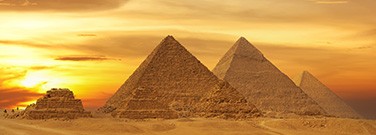Muography Moves Beyond the Pyramids

By Gina Wynn
When scientists discovered the presence of a hidden chamber inside Egypt’s Great Pyramid of Giza in 2017 using muography, it drew attention to the scientific value of the technology that is now helping researchers study the interiors of volcanoes, see inside shipping containers, and more.
An Out-of-This-World Technique
Muography is used to determine the density of a structure or landmass by measuring how many subatomic particles called muons are absorbed as they pass through it. Muons form when particles in space — called cosmic rays — collide with atoms in the Earth’s atmosphere. They continuously rain down on the Earth’s surface at different angles at nearly the speed of light, penetrating (or bouncing off) rock and whatever else is in their path.
Muons even pierce through your thumbnails about once every minute, according to the Science News Explores article “Muons reveal the inner worlds of pyramids, volcanoes and more,” by Emily Conover.
Particle Power
The successful use of muography in the Giza study that led to the discovery of the hidden space demonstrated that this type of particle physics could be useful in archaeology and in other disciplines as well. The details of the research were published in the November 2, 2017, Nature article “Discovery of a big void in Khufu’s Pyramid by observation of cosmic-ray muons.”
Muography can produce images of the insides of large objects without altering them, like the way X-ray or ultrasound machines in hospitals work on people. Unlike these other technologies, however, muography can span long distances and penetrate gigantic masses.
In the images, dark spots represent when muons bounced off large, dense objects, and bright spots indicate a gap that many muons were able to pass through. Color can also be used in the images: shades of red represent denser material and shades of blue mark less dense areas.
Muons are also plentiful and easy to detect with simple, compact devices that work with plastic strips and light sensors or photographic film. Common types of detectors include scintillation, nuclear emulsion, and gas. These devices can be placed in and around the structure being studied to gather data that helps map its internal density.
An Erupting Science
For some, muography offers an opportunity to better understand volcanoes and the danger they pose to communities. By creating a map of the channels inside a volcano and its other physical attributes, scientists may be able to learn how likely it is to erupt, potentially saving lives. If Mount Vesuvius that destroyed Pompeii, Italy, in A.D. 79 erupted again today, it would put 600,000 people living in the surrounding area in harm’s way.
As part of the Muon Radiography of Vesuvius experiment (MURAVES), a research team has set up muon detectors a little less than a mile from the volcano’s crater. After mapping muon and rock densities near its top, they found differences in density between the northwestern and southeastern sides. Their preliminary findings were published in the February 24, article “The MURAVES experiment: study of the Vesuvius Great Cone with Muon Radiography 2022,” at arXiv.org.
The team surmised that the volcano walls have been thickened by new layers of material from repeated eruptions. Knowing the strong and weak areas of Vesuvius’s structure can help them predict where walls could collapse or landslides could occur. Thus, the people in the most dangerous areas could be evacuated at the first sign of an eruption.
Controlling Commerce
Muography may have everyday applications as well. Through an EU-funded project called SilentBorder (silentborder.eu), particle physicists are using muon detectors to prevent the smuggling of radioactive materials. They can perform non-intrusive inspections of cargo containers by measuring how muons scatter when they hit materials made of heavy elements like uranium.
Now that European customs officers have realized the value of muography, it’s only a matter of time before other industries begin to harness the technology. The technique has come a long way since physicists first discovered muons in 1936 and wondered why they existed. Who would have thought that tiny particles from space would possess an unparalleled ability to uncover secrets of the past, expose concealed realms of the modern world, and maybe even predict natural disasters of the future?
Discussion Questions
- Have you ever had an X-ray? In what ways are X-rays similar to muography?
- Name some other invisible particles that exist in our universe. Where do you find them?